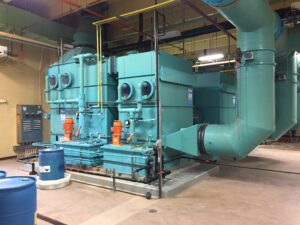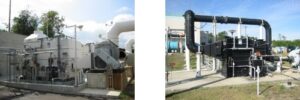Chemical Scrubbers: How They Work and Why They Matter for Odor Control
 Municipal and industrial facilities often face significant odor control challenges. Wastewater treatment plants, food processing facilities, and landfills generate odors that can affect nearby communities and regulatory compliance. Implementing effective odor control measures is crucial to maintaining a safe and pleasant environment.
Municipal and industrial facilities often face significant odor control challenges. Wastewater treatment plants, food processing facilities, and landfills generate odors that can affect nearby communities and regulatory compliance. Implementing effective odor control measures is crucial to maintaining a safe and pleasant environment.
Chemical scrubbers offer a reliable solution by removing odorous compounds from air streams. At Webster Environmental Associates (WEA), we specialize in designing and implementing odor control solutions that meet the specific needs of each facility.
How Chemical Scrubbers Work
Chemical scrubbers are engineered systems designed to remove odorous compounds from air emissions. They work by passing contaminated air through a vessel where it comes into contact with a liquid solution that absorbs and neutralizes odors. The process typically involves several components that ensure efficient odor removal.
The vessel is the structure that houses the scrubbing process and provides sufficient contact time between the air and the chemical solution. Packing material within the system increases the surface area and allows for more effective interaction between the air and liquid solution. A recirculation system continuously distributes the chemical solution, which helps maintain efficiency throughout the process.
Additionally, a mist eliminator captures liquid droplets before the treated air is discharged, which prevents chemical carryover. The chemicals used in the process oxidize or absorb odor-causing compounds such as hydrogen sulfide and ammonia. This results in cleaner air being released into the environment.
Where Chemical Scrubbers Are Used
Chemical scrubbers are used across various industries to address odor control challenges. Some common applications include:
- Wastewater Treatment Plants: These facilities generate odors from biological processes, and chemical scrubbers help manage emissions from headworks, digesters, and sludge handling areas.
- Biosolids Management: Storage and processing of biosolids release odors that can be effectively controlled with scrubbers.
- Industrial Facilities: Food processing plants, landfills, and petroleum refineries benefit from scrubbers to manage complex odor issues.
- Regulatory Compliance: Facilities must meet air quality standards set by environmental agencies, and chemical scrubbers provide an effective means to comply with these regulations.
Selecting the Right Chemical Scrubber
Choosing the right chemical scrubber requires a thorough understanding of the facility’s specific odor control needs. Several factors influence the design and performance of a scrubber system, including:
- Type of Odor Source: Identifying the primary sources of odors and the compounds involved is essential for selecting the appropriate chemical treatment.
- Chemical Selection: Different chemicals target specific odor compounds. Common options include sodium hypochlorite, caustic solutions, and acid scrubbing agents.
- Treatment Goals: Understanding the desired odor removal efficiency and operational requirements helps in designing a system that meets performance expectations.
At WEA, we conduct detailed evaluations to develop customized solutions that align with our clients’ goals. Our team assesses each site to determine the most cost-effective and efficient scrubber design.
Advantages and Challenges of Chemical Scrubbers
Chemical scrubbers offer several advantages that make them a preferred choice for odor control:
- High Removal Efficiency: They effectively reduce odor-causing compounds, even at high concentrations.
- Compact Design: Chemical scrubbers require minimal space and can be integrated into existing facility layouts.
- Scalability: Systems can be designed to accommodate both small and large-scale operations.
However, there are also considerations to keep in mind:
- Chemical Handling: Proper storage and handling of chemicals are required to guarantee safe operations.
- Maintenance Needs: Regular monitoring and servicing are necessary to maintain performance and avoid system downtime.
- Operational Costs: The cost of chemicals and energy consumption should be factored into the overall budget.
Why Partner with WEA for Chemical Scrubber Solutions
 WEA brings decades of experience in odor control engineering. This makes us a trusted partner for chemical scrubber solutions. Our approach is centered on providing unbiased, data-driven recommendations that prioritize effectiveness and cost-efficiency.
WEA brings decades of experience in odor control engineering. This makes us a trusted partner for chemical scrubber solutions. Our approach is centered on providing unbiased, data-driven recommendations that prioritize effectiveness and cost-efficiency.
- Independent Expertise: We are not affiliated with any specific manufacturers, which allows us to recommend the best technology for each project.
- Industry Experience: With over 750 successful odor control projects completed, our team has worked with municipalities, industries, and government agencies.
- Customized Solutions: We customize each scrubber system to meet the unique demands of our clients while ensuring compliance with environmental regulations.
Get Started with WEA’s Odor Control Solutions
Chemical scrubbers are a proven solution for controlling odors in various industries. WEA offers expert guidance to help clients identify and implement the most effective odor control strategies. Our team is dedicated to delivering solutions that improve air quality, enhance community relations, and meet regulatory standards.
Contact WEA today to learn more about our chemical scrubber solutions and how we can assist with your odor control needs.
